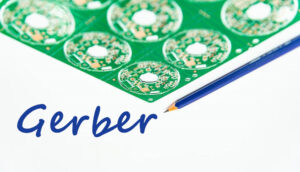Common Issues with Gerber and Solutions
2022-08-22One thing that all printed circuit board and PCB designs have in common is their reliance on high quality Gerber files. It also known as the backbone of the electronics manufacturing industry. In the digital age, electronics are very important to many different fields. Therefore, efficient and powerful PCB Gerber files enable PCB manufacturing to be done better, faster and easier.
A Gerber file can be defined as a PCB blueprint in digital format for the layer-by-layer printed circuit boards fabrication. Moreever, it is also an input for the PCB manufacturer, guiding the manufacturing and fabrication process in detail.
To start with, PCB designers will design PCB boards using a special set of tools, mainly with CAD and EDA, which help generate basic PCB manufacturing data. Therefore PCB manufacturer will produce based on the data provided by the Gerber file. If the customer provides the PCB design files without include the Gerber file, then production will face many difficulties.
Avoiding Gerber file problems is critical to the execution of PCB manufacturing
The following are some of the most common Gerber file problems encountered by PCB manufacturers.
-The Gerber file is missing or incomplete
Sometimes, Gerber files created for the same PCB are not necessarily identical in size and specification. A missing detail can change the entire configuration of the PCB by changing the size, shape or position of the holes on the board.
-Empty files
Design errors can result in the creation of zero-byte Gerber files that do not contain information that can be used for PCB fabrication and manufacturing. Hence, it is important to check the validity of the Gerber file before sending it to the PCB manufacturer.
-Insufficient internal clearance
This refers to the minimum clearance required between the drilled holes and the adjacent inner layers of copper interconnected on the PCB. Insufficient internal clearance can cause a short circuit in the internal copper layer during the drilling process.
-Wrong laminate layer
-Missing solder resist layer
If you have a PCB with two or more layers, the file must have two solder resist layers. One for the top layer and the other for the bottom layer.
-PCB dimensions do not match
-Missing drill file
Ensure that the holes drilled in the PCB are accurately positioned and sized.
-Incorrect file labels
Each Gerber file needs to follow standard naming conventions so that the manufacturer can easily understand its expected use.
-Excessive list of hole sizes
The potential for errors increases when multiple aperture lists are generating for each layer in a format different from that of the Gerber file.
Methods to avoid Gerber file errors
As problems with Gerber files can have time-consuming and expensive consequences, here are some suggestions to help you avoid issues with Gerber files.
- Use a Gerber file viewer to check the Gerber file
- Make PCB samples to ensure correct specifications
- Use HD CAD software
- Follow QA practices. Ensure that Gerber files are checked for completeness, correctness and length and validity
If you order your PCBs from KingPCB, you don't have to worry about errors caused by Gerber file issues. We carry out rigorous quality assurance, including Gerber file checks, to ensure you receive the highest quality printed circuit boards that perform at or above your expectations.
For proper advice or to share your requirements for the perfect PCB with a cost-effective strategy or to get a quote.




